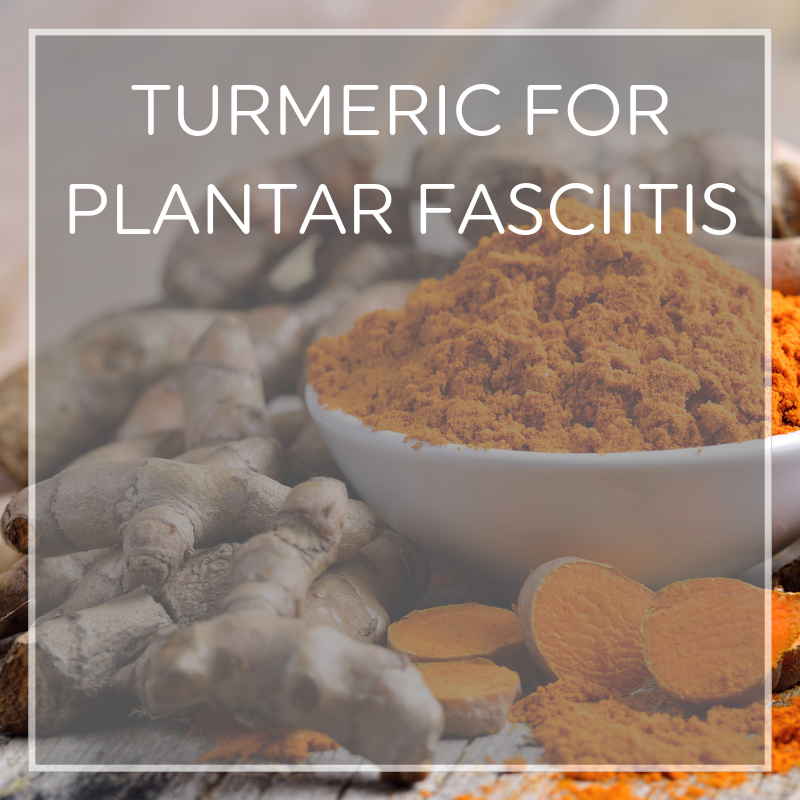 As it turns out, turmeric (more specifically its active compound, curcumin) is more than just a delicious seasoning for your favorite Indian takeout dish.
As it turns out, turmeric (more specifically its active compound, curcumin) is more than just a delicious seasoning for your favorite Indian takeout dish.
This fragrant yellow spice, a close relative of ginger, is also renowned for its anti-inflammatory properties, antioxidant effect, weight management support, and pain relief.
Wondering if supplementing with turmeric can help improve your heel pain or plantar fasciitis in a natural way? We have your answers!
Is Turmeric (Curcumin) Good for Plantar Fasciitis?
Turmeric (curcumin) shows a surprising number of health benefits that may improve heel pain from plantar fasciitis:
Pain Relief
One of the most compelling benefits of using turmeric for plantar fasciitis is its pain relief properties. One study conducted by the Cytokine Research Laboratory found that the curcumin in turmeric was a more effective anti-inflammatory than aspirin and ibuprofen, and has pain-relief properties on par with phenylbutazone and hydrocortisone.
This is fantastic news for people with chronic plantar fasciitis who are concerned about the negative side effects (like liver damage and ulcers) that can arise with long-term or heavy use of NSAIDs.
Antioxidant Properties
Curcumin is also renowned for its antioxidant properties — which can make a big difference in how quickly your body heals from damage to the plantar fascia!
The cells in your body create “free radicals” as part of their normal metabolic cycle. And when inflammation is present in the body, free radical production goes up. Without antioxidants (which neutralize free radicals), these harmful free radicals have the potential to further damage the cells and organs in the body. Adding antioxidants like curcumin to your diet while you recover from an injury can help your body heal.
Inflammation Reduction
When the plantar fascia becomes damaged through overuse or injury, the body sends a flood of proteins and cells to the injured area to do damage control. This immune response shows up as inflammation, swelling, and redness in the heels and arch of the foot.
A review of clinical research by Thorne Research showed that curcumin has significant anti-inflammatory properties that can improve injuries like muscle strain, sprains, and plantar fasciitis. One study conducted by the Universiti Kebangsaan Malaysia Medical Centre found that when mice were given curcumin for one month, several markers of inflammation (like paw thickness) decreased significantly.
Weight Management
Weight gain can put extra strain on the arch of the foot, increasing your risk of developing plantar fasciitis. Turmeric has been shown to help individuals maintain a healthy body weight by slowing the growth of fat cells, helping the body metabolize fat more easily, and preventing the formation of adipose tissue.
One study conducted by Velleja Research showed that after supplementing with curcumin, participants lowered their BMI by 2%-6%.
Using Turmeric for Inflammation
While there isn’t a standardized dose of turmeric to help improve your plantar fasciitis, many studies have concluded that, even at high doses, turmeric is safe for consumption. The most common mild side effect that you may notice is gastrointestinal discomfort, which can be avoided if you add turmeric to your diet slowly (instead of a high dose all at once!)
In general, it’s a good idea to take the most natural (organic and minimally processed) form of turmeric/curcumin that you can find, to help your body most easily absorb it.
The most common ways to use turmeric/curcumin include the following:
Turmeric Paste
You can make turmeric paste by mixing ¼ cup turmeric powder with ½ cup water, then heating on low until a thick paste is formed. This mixture can be kept in your fridge for several weeks. This paste can be eaten in turmeric milk (recipe below) or applied topically by mixing with coconut oil or olive oil spreading across the heel and arch of the foot. Massage this paste into the skin, wrap with plastic wrap, and leave on for an hour.
Turmeric Milk or Turmeric Tea
Add a piece of raw turmeric root (½ inch to 1 inch) or a teaspoon of turmeric paste to a cup of milk in a saucepan. Heat slowly to simmer, but do not boil. Any kind of milk (almond milk, coconut milk, cow’s milk) will work! For turmeric tea, repeat this same process with water. If you like, add a little bit of butter and maple syrup!
Curcumin Capsules
Curcumin can also be taken in concentrated form through capsules. Make sure you consult with a doctor on the right dosage for you before you begin taking curcumin capsules, since this method of taking turmeric is the most potent, and your doctor will have helpful insight into your unique health history.
Essential Oils
Curcumin can also be taken as a food-grade essential oil, either topically or by mouth. If you don’t like the taste of turmeric milk, this can be a good way to take turmeric in a concentrated form!
Keep in mind that, like other anti-inflammatories, turmeric is a blood thinner and should not be taken during pregnancy or before surgeries and medical procedures. Turmeric can also change how some medications interact with your body (like anti-depressants). When in doubt, talk to your doctor!
Treatments to Try in Addition to Turmeric
Keep in mind that while turmeric shows a lot of potential for lowering the inflammation and pain in your heels or feet, it won’t treat the underlying cause of your heel pain.
If you do decide to supplement with turmeric, make sure you use it alongside these proven remedies to banish your heel pain for good!
Orthotic Inserts
While inflammation certainly does play a role in plantar fasciitis and heel pain, most podiatrists believe that deterioration of the arch (including flattening, small tears, and micro-injuries) is the most common underlying cause of plantar fasciitis. By lifting, cushioning, and re-aligning the arch of your foot with high-quality orthotic inserts, you can help your damaged arch heal.
Click here to get 100% guaranteed orthotic inserts!

Icing
For fast pain relief that calms redness and swelling, ice your feet regularly. The cold from icing numbs pain receptors, and is just the ticket after a long day on your feet.
Rest
Rest is absolutely vital to addressing the cause of plantar fasciitis, since this condition is often a result of overuse. Take a break from high impact sports (like soccer or jogging), give your feet plenty of breaks from long periods of standing at work, and allow your arch time to recuperate and repair itself.
Stretching
Tight, inflexible muscles and tendons in the feet and legs can put you on a fast track to plantar fasciitis. Stretching the feet, heels, ankles, and calves can improve your strength and flexibility, as well as breaking up adhesions and improving circulation in the feet. While it might sound simple, stretching for a few minutes every day can make a significant difference in your pain!
Have you tried supplementing with turmeric? We’d love to hear about your experience in the comments below!




I have taken Tumeric for quite a long time. It does nothing for my heel pain from plantar fascitis. I still have great pain. I was surprised it was even mentioned for use in plantar f.
I don’t think Tumeric is of any help at all with heel pain from plantar fascitis. I have been taking it for a long time; about a year. I still have intense pain.
Turmeric did not help me. I am taking turmeric for last 2 years but there is no change in my pain. I think either it may be due to the dosage or rather the lack of efficacy of turmeric.
There is a new treatment for stubborn cases with simple injections of your own blood plasma done at the site by specialist doctors.
i have just started taking the capsules so who i go